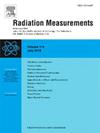Nuclear pulse pile-up rejection technique based on a symmetrical zero-area bald-top shaper
IF 2.2
3区 物理与天体物理
Q2 NUCLEAR SCIENCE & TECHNOLOGY
引用次数: 0
Abstract
Digital multi-channel pulse amplitude analyzer, known for its ballistic deficit immunity, high stability, and adjustable parameters, is widely used in high-resolution energy spectrum measurements of X-rays and gamma-rays. Digital multi-channel pulse amplitude analyzers employ fast and slow dual-channel pulse shaping algorithms used for pulse pile-up discrimination and pulse amplitude extraction, respectively. Traditional fast shaping channels utilize unipolar or bipolar triangular shapers to discriminate pulse pile-up, but the short shaping time reduces their filtering effect against high-frequency noise. This study proposes a symmetric zero-area bald-top shaper that features automatic baseline restoration capability, making it more minor baseline fluctuations at high counting rates. Experimental results of the characteristic X-ray energy spectrum measurements show that the proposed pulse shaper significantly reduces spurious peaks caused by pile-up at high counting rates compared to conventional fast shaping methods.
基于对称零区秃顶整形器的核脉冲堆积抑制技术
数字多通道脉冲幅度分析仪以其抗弹道缺陷、高稳定性和参数可调等优点而闻名,广泛应用于x射线和伽马射线的高分辨率能谱测量。数字多通道脉冲幅度分析仪采用快速和慢速双通道脉冲整形算法,分别用于脉冲堆积判别和脉冲幅度提取。传统的快速整形通道利用单极或双极三角形整形器来判别脉冲堆积,但整形时间短,降低了对高频噪声的滤波效果。本研究提出了一种对称的零面积秃顶整形器,具有自动基线恢复能力,使其在高计数率下的基线波动更小。特征x射线能谱测量的实验结果表明,与传统的快速整形方法相比,所提出的脉冲整形器在高计数率下显著降低了堆积引起的杂散峰。
本文章由计算机程序翻译,如有差异,请以英文原文为准。
求助全文
约1分钟内获得全文
求助全文
来源期刊

Radiation Measurements
工程技术-核科学技术
CiteScore
4.10
自引率
20.00%
发文量
116
审稿时长
48 days
期刊介绍:
The journal seeks to publish papers that present advances in the following areas: spontaneous and stimulated luminescence (including scintillating materials, thermoluminescence, and optically stimulated luminescence); electron spin resonance of natural and synthetic materials; the physics, design and performance of radiation measurements (including computational modelling such as electronic transport simulations); the novel basic aspects of radiation measurement in medical physics. Studies of energy-transfer phenomena, track physics and microdosimetry are also of interest to the journal.
Applications relevant to the journal, particularly where they present novel detection techniques, novel analytical approaches or novel materials, include: personal dosimetry (including dosimetric quantities, active/electronic and passive monitoring techniques for photon, neutron and charged-particle exposures); environmental dosimetry (including methodological advances and predictive models related to radon, but generally excluding local survey results of radon where the main aim is to establish the radiation risk to populations); cosmic and high-energy radiation measurements (including dosimetry, space radiation effects, and single event upsets); dosimetry-based archaeological and Quaternary dating; dosimetry-based approaches to thermochronometry; accident and retrospective dosimetry (including activation detectors), and dosimetry and measurements related to medical applications.
 求助内容:
求助内容: 应助结果提醒方式:
应助结果提醒方式:


